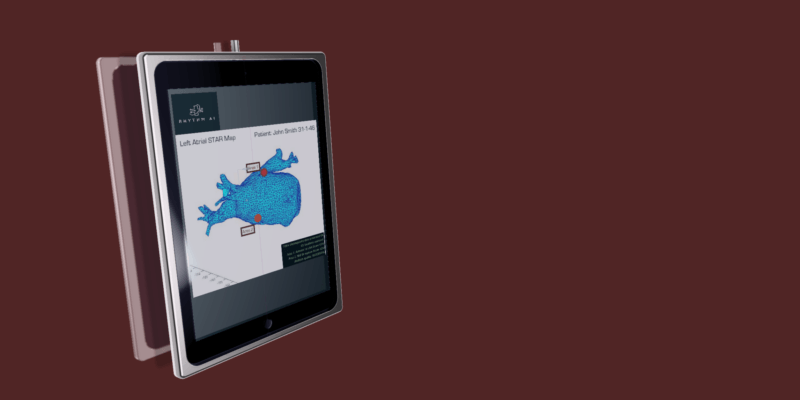 Yassir Javaid (Northampton, UK) discusses the use of cloud-based technologies and machine learning to improve the treatment and detection of arrhythmias.
Yassir Javaid (Northampton, UK) discusses the use of cloud-based technologies and machine learning to improve the treatment and detection of arrhythmias.
What potential is there for cloud-based data analytics and machine-learning to improve the outcomes of patients with atrial fibrillation?
Atrial fibrillation (AF) is the leading independent risk factor for stroke. According to Stroke UK it contributes to at least one in five strokes in the UK alone. However, it is not always that easy to spot. In fact, many patients are asymptomatic and up to a third are thought to be undiagnosed. Sadly, 50% of strokes caused by AF occur in undiagnosed patients.
The key to improving these outcomes is through earlier and more accurate detection. As with many cardiac-related conditions, timeliness of a diagnosis is essential. The sooner AF is diagnosed; the sooner medical practitioners can deploy the best course of treatment.
Today, modern technologies such as cloud-based data analytics and artificial intelligence can help doctors to detect, monitor and assess many different kinds of conditions. For cardiology specifically, these technological advancements have allowed for the development of new methods of monitoring for serious heart conditions, changing standards for both patients and practitioners. Some cardiac monitors are now powered by large heart-rhythm databases and can support the detection of serious conditions with greater accuracy. Poor signals and loose wires – both of which have previously caused critical loss of data– are no longer an issue, hugely improving the efficiency and speed of diagnosis.
These innovative technologies can significantly improve patient access and, in some cases, safety. For example, during the COVID-19 pandemic there has been a huge reduction in face to face contact. Healthcare professionals have been forced to adapt in order to ensure that patients still have access to potentially lifesaving and prognostic treatment and care. Direct-to-patient shipping models and embracing virtual appointments are key components of establishing a remote diagnosis. For AF, many doctors have been able to offer extensive monitoring and diagnosis from home and initiate preventative anticoagulation treatment through a virtual consultation. These new pathways, are set to play an increasing role moving forward as we move through the pandemic and address the backlog of patients where care has been deferred.
Will these technologies have a significant impact on how clinicians diagnose and manage arrhythmias over the coming years?
These technologies will almost certainly have an impact on how clinicians diagnose and manage arrhythmias over the coming years. Far from being a compromise, remote pathways in primary care —which involve remote diagnostics and cloud-based analytics—will provide a leaner and more efficient process than ever before.
With far fewer physical visits to a healthcare setting, remote cardiac pathways can have a positive impact on the patient experience, from both a convenience and safety point of view. The actionable heart data that these intelligent technologies collect, alongside the early detection they can achieve, could also have the potential to lower hospitalisation rates for the NHS, helping to address the ever-increasing burden on the system.
In addition the overall diagnostic yield for patients with suspected paroxysmal arrhythmia is likely to be significantly improved thanks to the longer initial monitoring period that these technologies offer. This should improve the identification and management for patients who might otherwise be undiagnosed.
How can the role of artificial intelligence in this area be further developed in the future?
Investment in modern and innovative technologies, such as artificial Intelligence, is already increasing in the healthcare space. Last year, Health Secretary, Matt Hancock, announced a £250 million investment to launch a new National Artificial Intelligence Lab, which will use the power of AI to improve cancer screening, modern heart disease and dementia treatments, as well as ensuring more personalised care for patients.
Moving forward, AI-powered technologies could do a lot towards helping to relieve some of the pressures placed upon the NHS by redefining how serious illnesses are clinically assessed and therefore treated. For example, when it comes to cardiac conditions, there is a need for diagnosis to be both rapid and accurate. Through using cloud-based data analytics and providing uninterrupted, comprehensive monitoring of a patient’s heart, intelligent technologies are able to achieve this.
In the future, it’s likely that artificial intelligence will continue to play an ever-increasing role in finessing diagnostic algorithms. If embraced, this type of technology could become one of the most powerful enablers the NHS has ever seen, helping to improve the accuracy and speed of diagnosis – saving lives and improving the patient experience.
How have you developed your new primary care model, and how has it been designed to improve the detection rate of AF and reduce stroke admissions?
For many years, I have been passionate about reducing unwarranted variation and ensuring standardised delivery of evidence based care with primary care cardiology. AF has been a huge focus and an outcome has been the development of a new primary care AF up-skilling programme, which is now RCGP (Royal College of General Practitioners) accredited. So far, the programme has been delivered in more than 12 Clinical Commissioning Groups, training over 500 GPs. Within our CCG we also created an electronic AF clinical template which runs across all GP software systems and sits within the patient notes. This facilitates the optimisation process in primary care, using patient decision aids to enable GPs to better diagnose and deliver treatment.
In my local CCG, we are in the process of developing this further for patients with paroxysmal AF or other suspected paroxysmal arrhythmia through considering remote diagnostic solutions like iRhythm’s Zio service. No matter where they are applied—whether in a GP surgery or at home—these devices can produce accurate and easy to read reports, improving the detection rate of AF and other arrhythmia and enabling much faster diagnosis and treatment or reassurance. For patients over 65 with hypertension, diabetes or other cardiovascular diseases, we strongly recommend point of care AF screening with pulse checks and follow up ECGs.
 Thanks to our systematic approach, we are now one of the best performing Clinical Commissioning Groups in terms of AF detection and anticoagulation in the UK. This is something we hope to make more widespread moving forward, particularly given the focus on cardiovascular conditions in the government’s 10-year plan.
Thanks to our systematic approach, we are now one of the best performing Clinical Commissioning Groups in terms of AF detection and anticoagulation in the UK. This is something we hope to make more widespread moving forward, particularly given the focus on cardiovascular conditions in the government’s 10-year plan.
Currently based at NHS Nene Clinical Commissioning Group, Yassir Javaid is a council member of the British Heart Valve Society.









